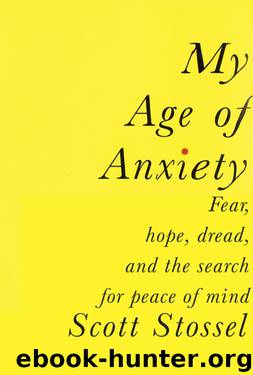My Age of Anxiety by Scott Stossel

Author:Scott Stossel [Stossel, Scott]
Language: eng
Format: epub
ISBN: 9780385351324
Publisher: Random House Inc.
Published: 2013-12-31T02:00:00+00:00
* * *
* I’ve just listed ten of the thirteen DSM criteria for a panic attack; the other three symptoms are feelings of depersonalization or unreality, fear of losing control or going crazy, and fear of dying. At least four of these thirteen symptoms must be present for a panic attack to have occurred, according to the DSM.
† Another way of characterizing this was as a victory of the neo-Kraepelinians over the Freudians. Many scholars consider Emil Kraepelin, not Sigmund Freud, to be the crucial figure in the history of psychiatry. Psychoanalysis, these scholars say, was just a blip; Kraepelin’s system of disease classification both predated Freudianism and outlasted it.
In 1890, when Freud was setting up his practice in Vienna, Kraepelin, then a thirty-four-year-old physician, took a professorship in psychiatry at Heidelberg University. While there, Kraepelin became interested in the symptoms of various mental illnesses. He and his residents would draw up a note card for each patient who entered his clinic at Heidelberg and would record on it symptoms and a preliminary diagnosis. Each card would then be placed in the “diagnosis box.” Every time a new symptom appeared, and every time a diagnosis was revised, the patient’s card would be taken from the box and updated. When the patient was released from the hospital, his or her disposition and final diagnosis would be recorded. Over the years, Kraepelin accumulated many hundreds of such cards, which he would take on vacation to study. “In this manner we were able to get an overview and see which diagnoses had been incorrect and the reasons that had led us to this false conception,” he wrote.
This systematic recording of patient symptoms and diagnoses may not seem novel today, but no one had attempted to apply such thorough observation and classification to mental illness before Kraepelin. (Actually, one exception here was astrologers. Through the Enlightenment, astrologers kept meticulous medical records so they could chart symptoms against astrological alignments, looking for correlations that would be useful to them in future diagnoses and treatments. This record keeping may in fact have made astrologers better able to prognosticate the course of diseases than doctors, who acted on intuition rather than systematic observation. Astrologers, in other words, may have been more likely to provide evidence-based medicine than doctors were.) Diagnoses were haphazard and random. Kraepelin’s goal in gathering all this data was to try to cleave nature at the joints—to identify the cluster of symptoms that characterized each mental disease and to project their development over the life course. Unlike Freud (who was ambiguous about whether mental illness was a medical disease or a psychosocial problem of “adjustment”), Kraepelin came to believe strongly that psychiatry was a subfield of medicine. Emotional disorders were biological entities that could be identified and differentiated the way measles and tuberculosis were.
Kraepelin used the symptom data he accumulated on his cards as the basis of the psychiatry textbook he published in 1883. Revised multiple times over the years, his Compendium der Psychiatrie came to be the most influential psychiatric textbook ever published.
Download
This site does not store any files on its server. We only index and link to content provided by other sites. Please contact the content providers to delete copyright contents if any and email us, we'll remove relevant links or contents immediately.
Should I Stay or Should I Go? by Ramani Durvasula(6815)
Why We Sleep: Unlocking the Power of Sleep and Dreams by Matthew Walker(5672)
Fear by Osho(4101)
Flow by Mihaly Csikszentmihalyi(4072)
Rising Strong by Brene Brown(3794)
Why We Sleep by Matthew Walker(3790)
Too Much and Not the Mood by Durga Chew-Bose(3705)
How to Change Your Mind by Michael Pollan(3693)
The Hacking of the American Mind by Robert H. Lustig(3592)
Lost Connections by Johann Hari(3462)
He's Just Not That Into You by Greg Behrendt & Liz Tuccillo(3320)
Evolve Your Brain by Joe Dispenza(3065)
What If This Were Enough? by Heather Havrilesky(2951)
Resisting Happiness by Matthew Kelly(2896)
Crazy Is My Superpower by A.J. Mendez Brooks(2873)
The Courage to Be Disliked by Ichiro Kishimi & Fumitake Koga(2816)
The Book of Human Emotions by Tiffany Watt Smith(2783)
Descartes' Error by Antonio Damasio(2752)
In Cold Blood by Truman Capote(2696)
